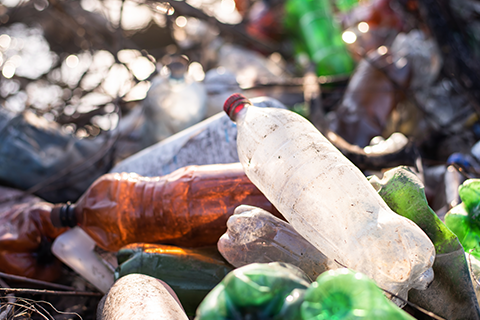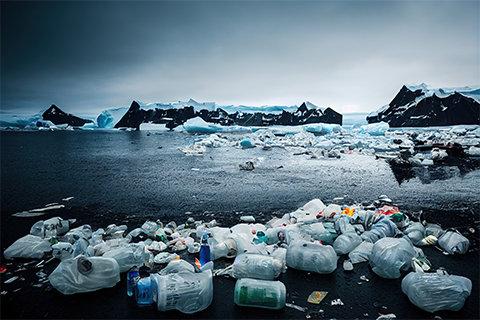January 23, 2023
Madhura Mohan
The Plastic Pollution Crisis – Facts & Information
E
ver wondered where the plastic bottle from which you consume juice, or the plastic tub from which you eat ice cream goes? To your dustbin, and from there, to the garbage van, and from there? No answer? This is the problem with humans, we never bother about the after-effects!
Right from toothbrushes, the first thing that we use in the morning, almost all aspects of our daily life like telecommunications, electronics, pens, clothing, footwear, and packaging materials that facilitate the transport of a wide range of food, and drink involve plastics.
While we can’t deny the truth that the invention of plastic has revolutionized the world, it has also plagued our planet!! Although plastic usage is convenient, our collective usage has a steep price. Rapidly increasing production and use of plastic globally overwhelms the ability to deal with plastic pollution.
As per statistics, plastic is produced on a massive scale worldwide and its production is crossing 150 million tonnes per year globally.
Plastic trash has become so ubiquitous and the effects of plastic pollution have become one of the most pressing global environmental issues today.
Raising awareness of the harmful effects of plastic waste and reducing plastic utility is the need of the hour to overcome the challenges of plastic pollution.
Plastic pollution is a vast topic, in our article, we’ll try to give brief information on what is plastic pollution, how plastic pollution is caused, and the harmful effect of plastic pollution.
WHAT IS PLASTIC?

The word, ‘plastic’ is derived from the Latin word, ‘plasticus’ which means capable of moulding. On a molecular level, plastics are made of polymers, which are long, flexible chains of chemical compounds. This structural aspect of plastic allows them to be easily moulded and shaped under pressure. Some of the earliest use of plastic dates as far back as 3500 years ago. During the mid-19th and 20th centuries, synthetic plastics like celluloid and bakelite made their debut and were used for decades.
HOW IS PLASTIC MADE?

Most of the plastic that is used today is manmade and is derived from fossil fuels, such as crude oil and natural gas. Around 4% of world oil production is used as feedstock to produce plastics.
Crude oil and natural gas are first extracted from the ground. The next step involves refinement where the fossil fuels are sent to refineries, where they are converted into several products, including the building blocks of plastic, ethane (from crude oil), and propane (from natural gas). Ethane and propane are then sent to a cracking plant where they are broken down into smaller molecules, ethane becomes ethylene and propane becomes propylene. These molecules are then mixed with a catalyst which links the molecules and forms polymers, called resins. Resins allows the plastic to be easily moulded in shapes under heat and pressure. The process of polymerization converts ethylene into polyethylene and propylene into polypropylene. Resins are heated, cooled, and chopped down into preproduction plastic pellets known as nurdles. Nurdles are later transported to factories where they use heat to transform the nurdles into different types of plastic products.
Polyethylene terephthalate (PET), High-density polyethylene (HDPE), polyvinyl chloride (PVC), Low-density polyethylene (LDPE), polypropylene (PP), Polystyrene (PS) are some of the well-known plastic.
WHAT IS PLASTIC POLLUTION?

The significant amount of plastic that isn’t recycled, the plastics thrown into unregulated dump sites, landfills, plastic that’s incinerated, all contribute to plastic pollution that end up damaging natural habitats, endangering marine life, and polluting communities around the world.
WHAT ARE THE PRIME CAUSES OF PLASTIC POLLUTION?

-
The versatility, affordable, durability, corrosion-resistant, high thermal and electrical insulation and convenience aspects of plastic have led to the increased utility of plastic, and hence the amount of plastic produced every year has increased exponentially. No wonder if the production and usage increase, so does the waste.
-
Much of the single-use plastics like straws, grocery bags, and food packaging products are particularly detrimental and contribute to 40% of all plastic waste. 91% of plastic is not recycled.
-
Irresponsible attitude when it comes to disposing of plastic or disposal of plastic is mismanaged. Plastic waste is often dumped into landfills, rivers, and oceans or burnt.
-
Plastic takes a long time to decompose (nearly 400 years) and plastics don’t degrade in the earth or water. They break down into smaller pieces called microplastics that pollute lands, oceans, and lakes.
HARMFUL EFFECTS OF PLASTIC

The massive amount of plastic waste can cause serious harmful effects on the natural environment.
SOIL INFERTILITY: Indiscriminate dumping of plastic in landfills leaches toxic substances to soil and makes soil less fertile. Since large amounts of chemical waste are washed through the soil into our groundwater due to rainfalls, our groundwater is likely to be contaminated.
GLOBAL WARMING: The incineration of plastic generates toxic chemical compounds such as carbon monoxide, chlorine, hydrochloric acid, dioxin, furans, amines, nitrides, styrene, and benzene. The harmful gases contribute to the greenhouse effect. These harmful gases trap the radiant heat of the sun and hinder it from escaping from the earth which causes global warming.
LITTER/CLUTTER: Littered plastic makes the city unclean, causes aesthetic problems, clutters drains and causes diseases, and affects tourism.
WATER POLLUTION: Plastic waste is dumped into water bodies like rivers, lakes, wells, and seas which adversely affect the water bodies and contributes to global warming.
THREAT TO MARINE LIFE: Millions of tonnes of land-based plastic make their way into the ocean every year. Plastic debris like pellets, fragments, and microplastics (containing polychlorinated bisphenyl, polycyclic aromatic hydrocarbons, alkyl phenols and BPA) which pollute oceans, and lakes, which can then be eaten by fish, seabirds, can cause a threat to human’s life when we consume seafood.
THREAT TO WILDLIFE: A large amount of plastic waste illegally disposed of in forests eventually ends up causing a threat to wildlife. Microplastic ingested by animals can cause choking, intestinal blockages, cause internal bleeding, leaching of chemicals from plastic products can transfer chemicals to wild life and could even result in their death.
INCREASED CARBON FOOTPRINT: Throughout its lifecycle, plastic carbon footprint (total greenhouse gas emission caused) is significantly high. The fossil-based product results in a carbon footprint formation of 4-6 tons of CO2 for the production of one ton of plastics.
After having read this piece of information, don’t you feel that the accumulation of plastic debris and associated consequences are largely avoidable?
AS-IT-IS MEASURE TOWARDS PLASTIC WASTE PLANETARY CRISIS
There’s no denying that plastic packaging has proven useful to many big brands and consumers alike, but when it comes to an unignorable environmental cost, disadvantages outweigh its benefits. Food packaging makes up about one-third of all the most commonly littered plastic.
A complete rethink of how the brands design and package their products can contribute to reducing plastic. Reducing the amount of plastic in packaging by just a few grams can make a huge difference across an entire product range.
Over the year, AS-IT-IS has cut the weight of plastic significantly through better and lighter designs.
Consumers can contribute to the mitigation of the plastic pollution problem if they support our efforts in low plastic packaging initiatives.
It’s time we get more responsible towards plastic usage to ensure a healthy, & safe planet…
Be mindful of the impact of plastic on our planet…minimize plastic usage & save earth…
Reference:
Also Read: Amino Spiking In Whey - What's Is? Is Your Protein Clean?
 Follow our Instagram page for the latest updates: badalkhudko
Follow our Instagram page for the latest updates: badalkhudko




 Follow our Instagram page for the latest updates: badalkhudko
Follow our Instagram page for the latest updates: badalkhudko








Comments
Leave a comment